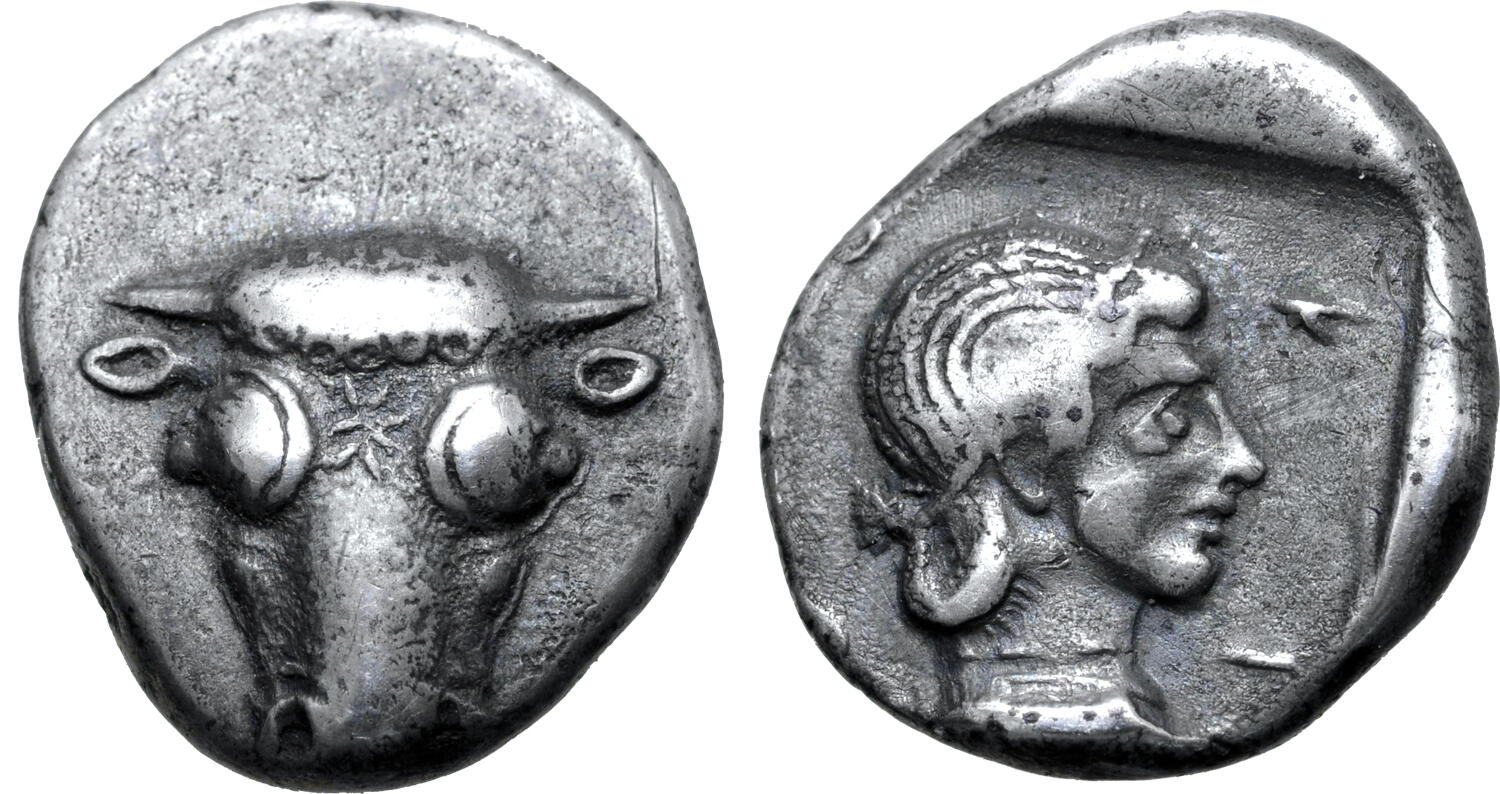S 1920 - Phocis (various mints) (Phocian League), silver, triobols (460-400 BCE)
From SILVER
460 BCE - 400 BCE Silver 4,329 kg
Description
| ObverseInscription or printing placed on the obverse.: | Head of bull facing |
| ReverseInscription or printing placed on the reverse.: | Φ-O-K-I (Greek).Head of Artemis to right, all within incuse square |
Mint and issuing power
| MintIdentifies the place of manufacture or issue of a numismatic object.: | Phocis (various mints) | Ancient regionAncient region.: | Phocis | Modern countryModern country: Greece | AuthorityIdentifies the issuing power. The authority can be "pretended" when the name or the portrait of X is on the coin but he/she was not the issuing power. It can also be "uncertain" when there is no mention of X on the coin but he/she was the issuing power according to the historical sources: | Phocian League |
Chronology
| FromIdentifies the initial date in a range assigned in a numismatic context. | 460 BCE | toIdentifies the final date in a range assigned in a numismatic context.. | 400 BCE | PeriodTime period of the numismatic object.: Classical 480-323 BC |
Physical description
| MetalThe physical material (usually metal) from which an object is made.: | Silver |
Median weightMedian of the weights of numismatic objects (in grams). in grams | 3.00 | DenominationTerm indicating the value of a numismatic object. Examples: tetradrachm, chalkous, denarius.: | triobol |
StandardStandard.: |
Image

S1920 Phocis triobols Gr. III-IV.jpg [1]
References
| Die study referencePublication of the study: | Williams 19721Williams 1972, p. 97-106, 108-113, n° 162-219, 234-265 (Periods III-IV) | ||
| Coin series referenceReference to coin series study: | Sear I2Sear I, n° 2350, HGC 43HGC 4, n° 1036 | ||
| Coin series web referenceCoin series web references: | |||
Obverse dies distribution
| FrequencyFrequency of specimen in distribution. ᵖ | Number of obversesNumber of obverse dies. ᵖ (o) | % (o) | Number of coinsNumber of coins. (n) | % (n) | Die nameName(s) of the die(s). |
| 1 | 21 | 34.43 | 21 | 9.13 | 117, 122, 130, 134, 140, 144, 146, 152, 155, 165, 166, 171, 172, 173, 175, 176, 181, 187, 188, 189, 190 |
| 2 | 9 | 14.75 | 18 | 7.83 | 128, 129, 137, 138, 142, 147, 150, 163, 186 |
| 3 | 9 | 14.75 | 27 | 11.74 | 120, 131, 132, 136, 145, 149, 167, 178, 182 |
| 4 | 5 | 8.2 | 20 | 8.7 | 151, 156, 168, 177, 179 |
| 5 | 5 | 8.2 | 25 | 10.87 | 133, 135, 148, 169, 180 |
| 6 | 3 | 4.92 | 18 | 7.83 | 121, 141, 164 |
| 7 | 2 | 3.28 | 14 | 6.09 | 118, 174 |
| 10 | 2 | 3.28 | 20 | 8.7 | 143, 170 |
| 11 | 2 | 3.28 | 22 | 9.57 | 153, 154 |
| 12 | 2 | 3.28 | 24 | 10.43 | 119, 183 |
| 21 | 1 | 1.64 | 21 | 9.13 | 139 |
| Total | 61 of 61 | 100.01 | 230 of 230 | 100.02 |
Reverse dies distribution
no distribution is available
Quantification
| Number of obversesNumber of obverse dies. ᵖ (o) | 61 | Number of singletons (o1)The number of singleton coins. ᵖ | 21 |
| Number of reverse diesNumber of reverse dies. (r) | Number of coinsNumber of coins. (n) | 230 | |
| Coins per obverse dieNumber of coins per obverse die. (n/o) | 3.77 | Coins per reverse dieNumber of coins per reverse die. (n/r) | |
| Reverse per obverse ratioRatio of obverse dies divided by reverse dies. (r/o) | Percentage of singletons (o1)number of coins (n) divided by the number of singletons (o1) ᵖ | 34.43 % | |
| Original number of dies (O) (Carter 1983 formula)The estimation of the number of coins according to Carter 1983 ᵖ | 72.15 | Coins struck if 20,000 as average productivity per dieCoins made if the average productivity for obverses (according to Carter) is 20,000. ᵖ | 1,443,000 |
| Original number of dies (O) (Esty 2011 formula)The estimation of the number of coins according to the singleton formula in Esty 2011 ᵖ (O) | 83.02 | Survival rate if 20,000 as average productivity per dieSurvival rate if average productivity is 20,000. ᵖ | 0.00016 |
| Coverage (o = % of O) (Esty 1984 formula)Esty 1984 - coverage (% of O) ᵖ (o = % of O) | 90.87% | Die productivity if survival rate 1/2,000Average productivity if survival rate is 1/2,000. ᵖ | 6,375.61 |
| Weight of silver (in kg) if 20,000 coins per die (O = Carter formula)Carter 1983 * Median weight * 20000 (*10 if gold or electrum) ᵖ | 4,329 kg <br /> 4,329 kg | Die productivity if survival rate 1/5,000Average productivity if survival rate is 1/5,000. ᵖ | 15,939.02 |
Remarks